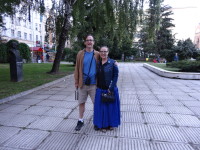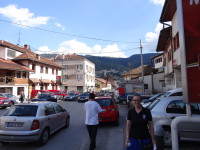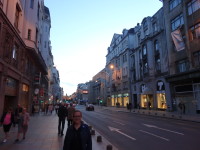 This was the first of two days of long drives. We started the day in Plitvice, where we basically packed up the car and left around 10:00, and we headed to Sarajevo, in Bosnia-Herzegovina, which should be about five hours away, but, after two pit stops and some tense we’re-lost driving, took us about six hours. And since we did not have any money yet, in the local and suspiciously named “konvertible mark,” we did not stop for lunch. Another moment for the marital bliss book (actually, we both did surprisingly well, considering, as I put it, “I’m a stupid American in a Croatian car in Sarajevo. How does this happen?”).
This was the first of two days of long drives. We started the day in Plitvice, where we basically packed up the car and left around 10:00, and we headed to Sarajevo, in Bosnia-Herzegovina, which should be about five hours away, but, after two pit stops and some tense we’re-lost driving, took us about six hours. And since we did not have any money yet, in the local and suspiciously named “konvertible mark,” we did not stop for lunch. Another moment for the marital bliss book (actually, we both did surprisingly well, considering, as I put it, “I’m a stupid American in a Croatian car in Sarajevo. How does this happen?”).
 Anyway, we landed in Sarajevo. We found our B and B only after one of the more amazing acts of kindness I have ever seen: we overshot the area likely to hold our B and B after thirty minutes of tense I-can’t-read-the-signs-that-I’m-not-seeing, and we pulled off at an exit to another road. The car behind us pulled after us, even though it seemed a minor road. The man pulled up next to us and said something we did not understand. We told him we only spoke English, so he pulled ahead on the road and got out of his car and came back to ours to explain in broken English how to get to the main square our B and B was near. He then drove ahead of us to show us the road back into the main part of Sarajevo. That was impressive kindness, and it helped diffuse the tension in the car significantly, until I saw my parking spot.
Anyway, we landed in Sarajevo. We found our B and B only after one of the more amazing acts of kindness I have ever seen: we overshot the area likely to hold our B and B after thirty minutes of tense I-can’t-read-the-signs-that-I’m-not-seeing, and we pulled off at an exit to another road. The car behind us pulled after us, even though it seemed a minor road. The man pulled up next to us and said something we did not understand. We told him we only spoke English, so he pulled ahead on the road and got out of his car and came back to ours to explain in broken English how to get to the main square our B and B was near. He then drove ahead of us to show us the road back into the main part of Sarajevo. That was impressive kindness, and it helped diffuse the tension in the car significantly, until I saw my parking spot.
We found our B and B, and I was directed to the “garage,” which is a Bosnian word meaning “storage shed.” Meredith got our stuff out of the car, and I did manage to fit the vehicle in the space provided, but it was a near thing. Once I was parked, it was all the gut-sucking action I could manage to get out of my door.
The first order of business after getting checked in was to get some konvertible marks from the local ATM, quickly followed by supper. We wandered into the market square area, which had the feel of a Turkish bazaar (or at least my TV-fueled version of one). We found a Rick-Steves-recommended restaurant specializing in a local dish called burek, which is a wonderful pastry, stuffed with potatoes, and then wood-fired. Yum. That was followed by cheap pastries from a bakery (prices are low here). Finally fed properly, I was ready to tour.
 We saw the newly finished town hall (the original was destroyed in the war in the 1990s), wandered the market street a little bit, and got to note where it changed from eastern-style Turkish buildings from the Ottoman Empire days to the newer Austro-Hungarian Empire days, and it really changes on a line – they even have it marked in the pavement (an “east meets west” kind of line). We finished up our solo wanderings down by the river, stumbling on the Latin Bridge, which is within a few feet of where Archduke Ferdinand was assassinated, which helped start WWI.
We saw the newly finished town hall (the original was destroyed in the war in the 1990s), wandered the market street a little bit, and got to note where it changed from eastern-style Turkish buildings from the Ottoman Empire days to the newer Austro-Hungarian Empire days, and it really changes on a line – they even have it marked in the pavement (an “east meets west” kind of line). We finished up our solo wanderings down by the river, stumbling on the Latin Bridge, which is within a few feet of where Archduke Ferdinand was assassinated, which helped start WWI.
We walked back to our B and B, where we met a local guide – a retired teacher who had lived through the war in the 90s. She took us on a three-hour walking tour of the city, and was very informative. She showed us a bunch of things; some things that stood out to me:
– Sarajevo is a tolerant city. Within a few blocks, we saw several mosques, a large Catholic church, a large Orthodox church, several synagogues, and a Protestant church. When Pope Francis was here a few weeks ago, he was given a chair carved by a Muslim family.
– Our guide filled in more details of the sharp east/west line, saying it was unique in the world as a place where you could stand in one spot and see such a sharp architectural divide.
– She took us up to a ninth-floor lounge with outdoor seating to show us the whole of the city at twilight (Meredith loved it; I was scared of the height).
– Our guide filled us in on the details of the assassination of the archduke. One attempt was made on his life that failed, but wounded a guard. Thirty minutes later, the archduke was heading back from city hall and wanted to visit the guard. No one told his driver, who turned down a street as originally planned. A general told him to reverse and go back to the first street; when the driver tried to do that, a second assassin saw his chance and shot the archduke.
– There are still shrapnel holes around the city. The bigger holes are filled in with a red cement to mark where shells fell. No house in the city escaped some kind of damage over the 1,400 days of the siege.
 Our walk took us from daylight hours, to twilight, to evening in Sarajevo. Evenings are special in cities, especially when it is a pedestrian area. I enjoyed our brief time here in the city. It firmed up some older and newer history for me, and also made me happy at a vibrant city that seems to be getting along well.
Our walk took us from daylight hours, to twilight, to evening in Sarajevo. Evenings are special in cities, especially when it is a pedestrian area. I enjoyed our brief time here in the city. It firmed up some older and newer history for me, and also made me happy at a vibrant city that seems to be getting along well.
Tomorrow is another long-travel day of about five hours, assuming I can get my car out of the “garage.”